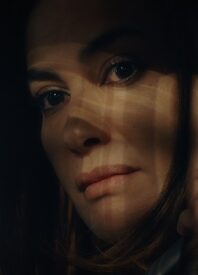
Olfa Hamrouni’s trauma starts before her titular four daughters arrive. To tell this story, she and actress Hend Sabry take turns playing Olfa. Olfa is a Tunisian woman who begins the film by recreating her wedding night. Her husband (Majd Mastoura, who plays two other male roles) tries to sexually assault her but she instead physically assaults him back. She then shows to others a sheet with blood from his face instead of from her womanhood.
Scenes like this in Four Daughters expose Olfa’s complexities. Olfa is victim and victimizer with her husband who never gets screen time after that one scene, and she’s both while raising her daughters. There are permutations within within her family’s power dynamics. And those dynamics become more dangerous as her daughters grow up, and her eldest two, Ghofrane (Ichraq Matar) and Rahma (Nour Karoui), fall under a few influences. Some are harmless to Western eyes, like going through a goth phase.
Others are worse, like when these daughters fall under Daesh’s influence. In telling Olfa’s story, Four Daughters mixes those reenactments with discussions between the actors and the interviewees. Olfa’s younger daughters did not fall under Daesh’s influence, but they still get to appear on screen as themselves and relive the trauma of living with their mother and losing their sisters. Other scenes in the mix are warm up exercises.
In this blend of documentary and drama, both the actors and the interviewees use acting as therapy. Although there are moments when the film captures itself almost going off the rails. Sometimes, the interviewees push the actors, and at other times, it’s the other way around. But the film also bears witness to the actors and interviewees pulling back when they need to. Its imagery in capturing those moments is ambiguous in a good way.
Some moments start out beautifully, like one when Sabry reaches out to one of her daughters. But as that moment goes on, tenderness turns into violence, like tough love going too far. Film, in Four Daughters’ case, is, theoretically, an act of honesty. The actors are there when they want limits to that honesty, understandably reluctant to retrace the steps that got them to where they are now. There’s another scene in Four Daughters that shows how much it succeeds at aiming for a larger truth.
That scene is when Karoui, deep in character, tells the real Olfa that the latter will burn in hell for not wearing a burqa. There are so many levels to that scene. I can imagine a child telling their mother that they will burn in hell is a hellish experience for a parent. But it also made me realise how much this moment is a part of a bigger history. We all know what Daesh is but most people in the West will never understand it.In Four Daughters, director Kaouther Ben Hania plays with a bigger canvas than she did with Beauty and the Dogs.
Although, she didn’t delve into the actresses’ relationship with Daesh, if any. The actresses handle the material with sensitivity. But at the end of the day, their lines are just lines to them. We hope that the actors never experience what Olfa experienced, but with that is an inevitable barrier between two groups. There’s hearing about history as it unfolds, and living it in all its pain. We assume that people have the same experiences because of how they look, but they don’t.
- Rated: TP
- Genre: Documentary, Drama
- Release Date: 9/7/2023
- Directed by: Kaouther Ben Hania
- Starring: Hend Sabry, Ichraq Matar, Majd Mastoura, Nour Karoui
- Produced by: Habib Attia, Martin Hampel, Nadim Cheikhrouha, Thanassis Karathanos
- Written by: Kaouther Ben Hania
- Studio: Red Sea Fund, Tanit Films, Twenty Twenty Vision Filmproduktion, ZDF/Arte

